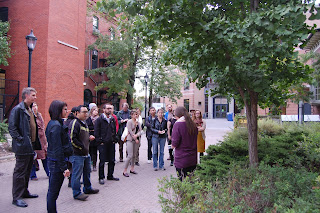
‘Urban forestry’ may sound like an oxymoron and is likely a new term for many. I, myself had only heard of the discipline just over a year ago when I started thinking of forestry as a possible career shift. Before that I would think of forests as remote areas, provincial or federal parks, and very rarely would I see city centres as being part of a forest. Sure, I knew that there were trees along streets, in urban parks, in backyards, and suburbs, but it was less clear why the often sparse cover of urban trees should be referred to as a collective forest.
Urban forestry is the planning, care, and management of urban tree populations as well as the surrounding ecosystem. The populations are managed as part of the greater urban infrastructure with an end goal of providing physiological, social, and economic benefits to society in both the short and long-term. Coined in the 1960s, by Eric Jorgensen, urban forestry was born at a time of crisis (Dutch Elm Disease) when it became evident that management would require much more than the mere planting of trees, but planning for sustainability and preparing for the challenges to come.
The urban forest improves air quality, provides shade, reduces runoff from storm-water, provides habitat for wildlife and has been shown to increase property value, reduce mental stress, and lower crime rates. These benefits that are important to the well-being of city dwellers can also reduce costs related to temperature regulation and health-care.
So why isn't urban forestry a priority at the municipal level? Well, the unfortunate truth is that trees are usually an after-thought in the urban planning process and are often planted for aesthetics with little attention beyond a minimum standard paid to specific planting requirements, resource needs and biodiversity.
Pollution, limited resources, physical and chemical damage, and soil compaction, plague urban trees and can result in reduced life expectancy and increased susceptibility to disease and attack by invasive species. Some trees are planted in root areas so small that the planting boxes have been termed 'tree coffins' (shown in the image above). How's that for foreshadowing? You see these at shopping malls and along the sides of streets, and unfortunately this extreme practice isn't all that uncommon.
On the bright side, it's not all doom and gloom. Fortunately, there is a lot of great work being done both at the government and non-government level with some local and national organizations like Local Enhancement and Appreciation of Forests (LEAF), Tree Canada Foundation, and NeighbourWoods, who are working hard to either advocate, educate or provide information and services to those interested. These organizations and many others are planting the seed, however, it will take a collective effort from municipalities, institutions, business and residents, alike to change the way urban forests are managed both on public and private land.
So what can be done? For starters, we can get rid of the tree coffins, increase root and canopy space through innovation, and start planting native cultivars from a diversity of species. We can manage for a vital forest, rather than a few pretty, but ill-fated trees. It is likely that we'll see another Dutch Elm Disease or Emerald Ash Borer in our time, so given that it is inevitable, why not make it harder for these Invasives to flourish? When it comes down to it, there will not always be funds available to constantly replace trees, so it's either change our ways now or get used to the concrete jungle.
Can't get enough? Why not read more? Get involved?
City of Toronto: Urban Forestry Services
Urban Forestry - Tree Canada
Forest History Society of Canada: Urban Forestry
Local Enhancement of Forests (LEAF): The Urban Forest
Ontario Nature Magazine
source of image: http://www.tdc.ca/treecare.htm
 Tree identification is a cool skill to have even for the fun of it. Like pointing out the constellations, it can be a great way to impress your friends. But even more than that, being able to tell the difference between a black walnut and a green ash can give you a greater appreciation for the urban forest - and how to properly manage it.
Tree identification is a cool skill to have even for the fun of it. Like pointing out the constellations, it can be a great way to impress your friends. But even more than that, being able to tell the difference between a black walnut and a green ash can give you a greater appreciation for the urban forest - and how to properly manage it. We were excited when our course had the highest turnout of all. Susan said it “really emphasized how important trees are to the community.” And we both agreed, the enthusiasm and questions were remarkable.
We were excited when our course had the highest turnout of all. Susan said it “really emphasized how important trees are to the community.” And we both agreed, the enthusiasm and questions were remarkable.


